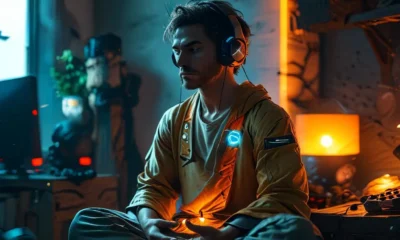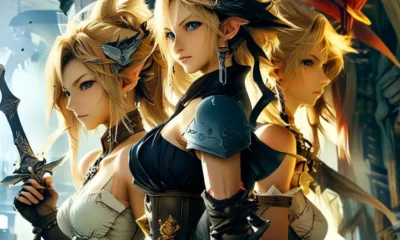Features
The Magic of Nintendo: How Mario and Zelda Connect us to Our Inner Child
Nintendo is special. Many excellent developers depend upon story or progression systems to entice engagement, but not Nintendo. Nintendo games captivate because of their immediate charm. There is no need for a payoff. The games, themselves, are enough: they elicit feelings, hard to find in adulthood. Through intrepid discovery, playful presentation, and unfiltered whimsy, the best of Nintendo connects gamers to their childlike selves.
The heart of any great Nintendo game is discovery and no encounter encapsulates this better than Breath of the Wild’s Eventide Island. First, finding the island requires genuine gumption. Found far from Hyrule’s shore, the island is only clearly visible from other islands, and even then, it’s only a speck in the distance. Reaching the island requires players to brave the open ocean and head towards something … that could be nothing. Then, upon arriving on the beach, a spirit takes all the player’s gear, including clothes and food. Link, literally, is left in his underwear. From there, players must make clever use of Link’s base skills in order to steal enemy weapons and make traps. The scenario creates a marvelous sense of self-sufficiency brought on by one’s own desire to discover. The player comes to the island purely of their own choosing, tackles the sea, and then overcomes obstacles without the aid of their strongest tools. The game turns players into plucky children who are discovering they can take care of themselves.
The intrepidity of Breath of the Wild and other Nintendo greats mirrors the feelings Shigeru Miyamoto, the father of many Nintendo franchises, experienced as a child. “I can still recall the kind of sensation I had when I was in a small river, and I was searching with my hands beneath a rock, and something hit my finger, and I noticed it was a fish,” Miyamoto told the New Yorker. “That’s something that I just can’t express in words. It’s such an unusual situation.” In sequences like Eventide Island, players don’t just understand what Miyamoto describes, they feel it: Apprehension gives way to exhilaration as the unknown becomes a place of play.
Nintendo’s intrepid gameplay is often amplified by playful presentation with Super Mario World 2: Yoshi’s Island being the quintessential example. The game’s visuals, defined by pastel colors and simple hand-drawings, appear crayoned by a child while the celestial chimes that punctuate the jubilant soundtrack evoke shooting stars. The overall effect cannot be understated. It takes the surreal and turns it real, allowing players to interact, tangibly, with imagination.
Even if one removes the presentation and gameplay from Nintendo’s masterpieces, an unabashed creativity remains that bucks norm and convention. The arbiter is fun; reason and logic have no say. For instance, Super Mario Odyssey’s Wooded Kingdom, takes place in a post-apocalyptic setting akin to Nier Automata. Players explore the metal remnants of a civilization that has become a lush home to robotic beings. However, unlike Nier, the dark undertones of the past have no bearing on the game or those who inhabit its universe. The post-apocalyptic setting is just a fun backdrop. It’s as though a bunch of children got together, began playing with toys, and one of the kids brought along his sibling’s adult action figures. There is no attention paid to the context, only unfiltered imagination.
When they’re at their best the creators at Nintendo invite gamers to come and play, like a parent arranging a play date. Pulled along by joyful gameplay that expands in unforeseen ways, players desire to play for the sake of play. It’s a halcyon state of being: No messy thoughts or contradiction, just joy.

-

 Features4 weeks ago
Features4 weeks agoDon’t Watch These 5 Fantasy Anime… Unless You Want to Be Obsessed
-

 Culture3 weeks ago
Culture3 weeks agoMultiplayer Online Gaming Communities Connect Players Across International Borders
-

 Features4 weeks ago
Features4 weeks ago“Even if it’s used a little, it’s fine”: Demon Slayer Star Shrugs Off AI Threat
-

 Features2 weeks ago
Features2 weeks agoBest Cross-Platform Games for PC, PS5, Xbox, and Switch
-

 Game Reviews4 weeks ago
Game Reviews4 weeks agoHow Overcooked! 2 Made Ruining Friendships Fun
-

 Features2 weeks ago
Features2 weeks agoThe End Is Near! Demon Slayer’s Final Arc Trailer Hints at a Battle of Legends
-

 Features3 weeks ago
Features3 weeks ago8 Video Games That Gradually Get Harder
-

 Game Reviews4 weeks ago
Game Reviews4 weeks agoHow Persona 5 Royal Critiques the Cult of Success
-

 Features2 weeks ago
Features2 weeks agoDon’t Miss This: Tokyo Revengers’ ‘Three Titans’ Arc Is What Fans Have Waited For!
-

 Uncategorized3 weeks ago
Uncategorized3 weeks agoSleep Meditation Music: The Key to Unwinding
-

 Guides2 weeks ago
Guides2 weeks agoHow to buy games on Steam without a credit card
-

 Game Reviews2 weeks ago
Game Reviews2 weeks agoFinal Fantasy VII Rebirth Review: A Worthy Successor?




